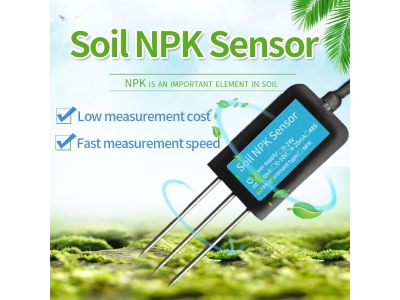Introduction Soil is a vital component of the Earth's ecosystem, playing a crucial role in supporting plant life and regulating the water cycle. Understanding the complex interactions within soil is essential for sustainable agriculture, environmental conservation, and land management. In recent years, advancements in sensor technology have opened up new possibilities for studying soil in unprecedented detail. Soil sensors have the potential to revolutionize our understanding of soil health and productivity, leading to more efficient and sustainable land use practices. This article explores the emerging field of soil sensor technology and its implications for agriculture, environmental science, and beyond.

The Importance of Soil Soil is a dynamic and complex environment that hosts a myriad of biological, chemical, and physical processes. It serves as a habitat for countless organisms, ranging from microscopic bacteria to earthworms and larger animals. Additionally, soil plays a crucial role in nutrient cycling, water retention, and carbon sequestration. The health and quality of soil directly impact agricultural productivity, ecosystem stability, and the global climate.
Traditionally, soil monitoring and analysis have relied on labor-intensive and time-consuming methods, such as soil sampling and laboratory testing. While these approaches have provided valuable insights, they are limited in their spatial and temporal resolution. Soil conditions can vary widely across different locations and change rapidly in response to environmental factors. As a result, there is a growing need for real-time, high-resolution monitoring techniques to better understand the dynamics of soil processes.
Enter Soil Sensors Soil sensors are innovative devices designed to measure various properties of soil, including moisture content, temperature, nutrient levels, and pH. These sensors come in a variety of forms, from simple handheld devices to sophisticated networked systems that can be deployed across large areas. By continuously monitoring soil conditions, sensors offer a wealth of data that can be used to make informed decisions about irrigation, fertilization, and other land management practices.
One of the key advantages of soil sensors is their ability to provide real-time data, allowing farmers and land managers to respond quickly to changing soil conditions. For example, by monitoring soil moisture levels, farmers can optimize irrigation schedules to minimize water usage and prevent waterlogging, which can lead to crop damage and nutrient leaching. Similarly, by monitoring nutrient levels, farmers can apply fertilizers more precisely, reducing waste and minimizing environmental impact.
In addition to their applications in agriculture, soil sensors have significant potential in environmental science and conservation efforts. By monitoring soil health in natural ecosystems, researchers can gain insights into the impacts of human activities, such as deforestation and urbanization, on soil quality and biodiversity. This information is crucial for designing effective conservation strategies and restoring degraded landscapes.
Challenges and Opportunities While soil sensors hold great promise, their widespread adoption faces several challenges. One of the primary obstacles is the cost of deploying and maintaining sensor networks, especially for small-scale farmers and resource-constrained regions. Additionally, interpreting the vast amount of data generated by soil sensors requires advanced analytical tools and expertise, which may not be readily available to all users.
Despite these challenges, ongoing advancements in sensor technology and data analytics are opening up new opportunities for overcoming these barriers. For instance, the development of low-cost, user-friendly sensor devices is making soil monitoring more accessible to a wider range of users. Furthermore, the integration of sensor data with machine learning algorithms is enabling more accurate predictions and automated decision-making processes.
Looking Ahead As the field of soil sensor technology continues to evolve, there are exciting prospects for its future applications. For example, the integration of soil sensors with precision agriculture techniques, such as automated machinery and drone-based monitoring, has the potential to revolutionize farming practices, leading to greater efficiency and sustainability. Moreover, the use of soil sensors in conjunction with climate models can enhance our understanding of the intricate feedback loops between soil, vegetation, and the atmosphere, contributing to more accurate predictions of climate change impacts.
In conclusion, soil sensors represent a powerful tool for unearthing the secrets of soil and unlocking its full potential. By providing real-time, high-resolution data on soil conditions, sensors have the capacity to revolutionize agriculture, environmental science, and land management practices. While challenges remain, ongoing advancements in sensor technology and data analytics are paving the way for a future where soil sensors play a central role in promoting sustainable and resilient ecosystems. As we continue to explore the capabilities of soil sensors, we are poised to gain deeper insights into the intricate workings of the Earth beneath our feet.
In summary, soil sensors have the potential to revolutionize our understanding of soil health and productivity, leading to more efficient and sustainable land use practices. This article explores the emerging field of soil sensor technology and its implications for agriculture, environmental science, and beyond.






